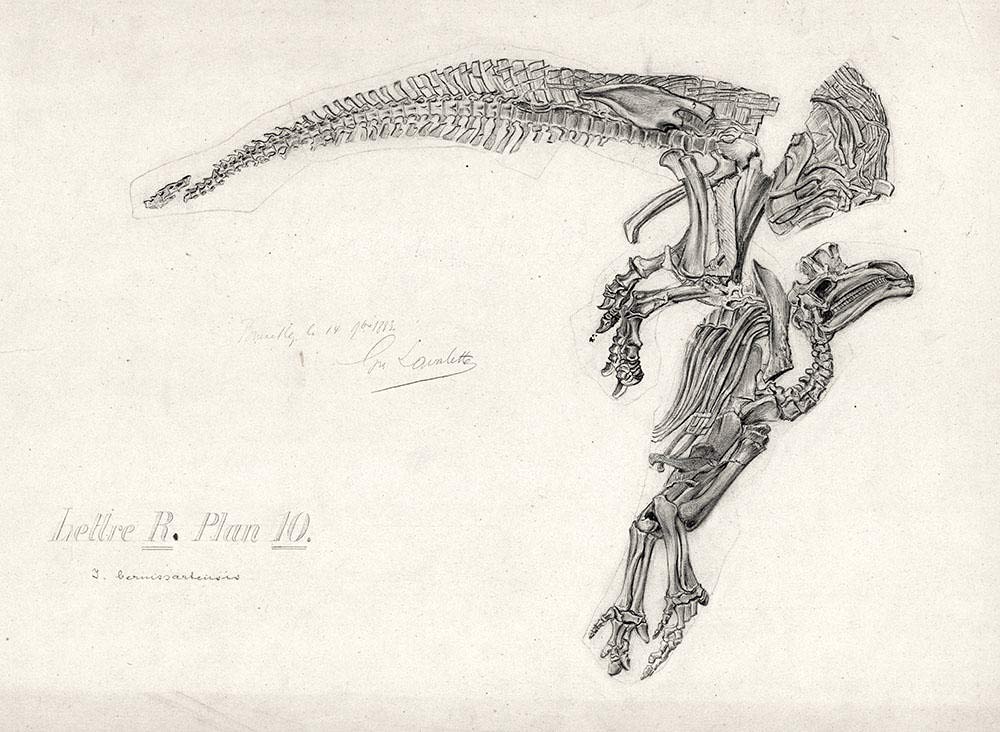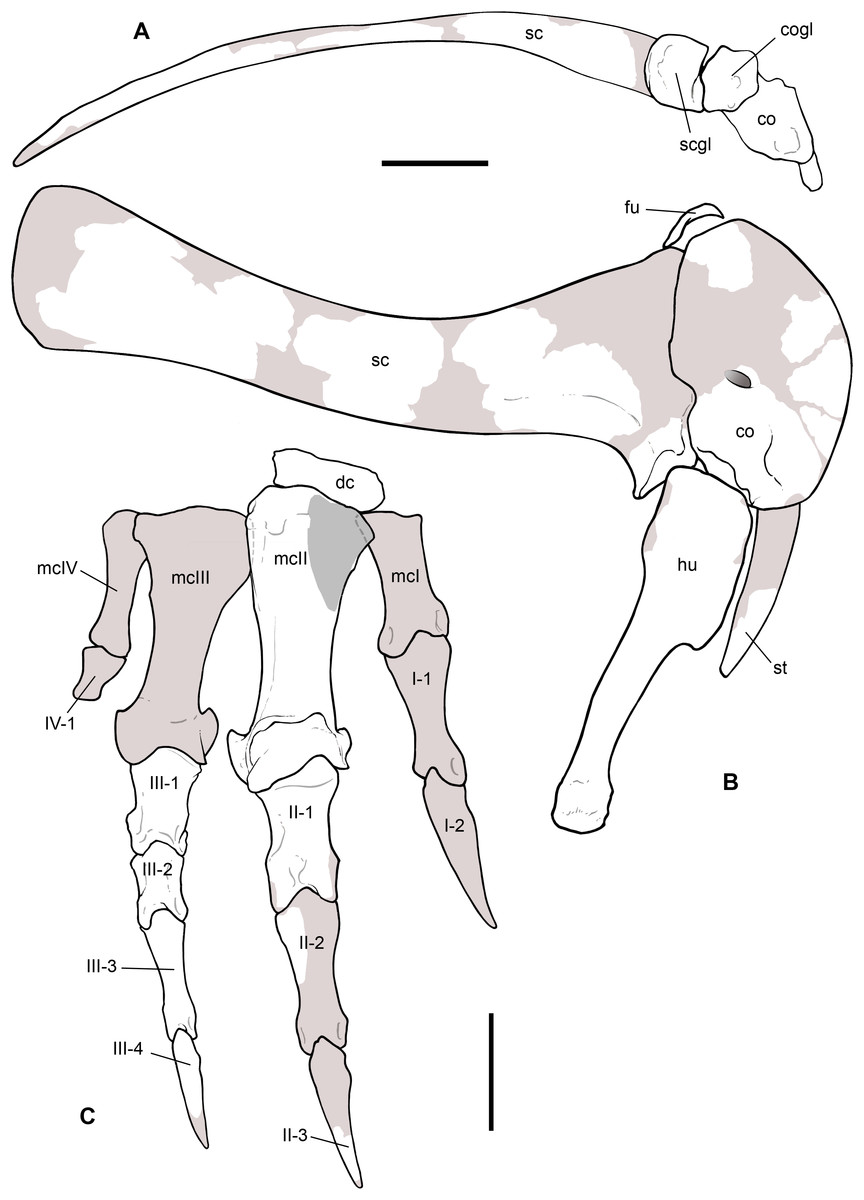|
Tethyshadros
''Tethyshadros'' ("Tethys Ocean, Tethyan hadrosauroid") is a genus of Hadrosauroidea, hadrosauroid dinosaur from the Late Cretaceous (Campanian) Calcare di Aurisina (previously thought to come from the younger Liburnia Formation) of Trieste, Italy. The type and only species is ''T. insularis''. Discovery and naming Sometime in the 1980s, Alceo Tarlao and Giorgio Rimoli reported finding fragments of dinosaur bone while prospecting for rare bones. The abandoned quarry these were found in was only 100m inland, at Villagio del Pescatore, Trieste Province, Italy. It was from this quarry that a nearly complete hadrosaur skeleton was discovered in 1994. Lying on a vertical rockface, the specimen required a difficult excavation process, involving the removal of over 300 cubic metres of mineral and use of large equipment. Palaeontologist Fabio Della Vacchia among others served as scientific director for the excavation. Many other fossils, including various other hadrosaur specimens, were ... [...More Info...] [...Related Items...] OR: [Wikipedia] [Google] [Baidu] |
Calcare Di Aurisina
The Calcare di Aurisina (Also known as Aurisina Formation, “Formazione di Monrupino”, Trieste Karst Limestone formation, “Repen formation”, “Sežana formation” and “Lipiza formation”) is a Mesozoic geologic Formation (geology), formation in Italy and Slovenia. This Limestone, limestones are found in the Trieste area and are of Late Cretaceous (Santonian-Campanian) age, being a local record of Carbonate platform limestones, historically quarried by cutting large blocks using steel wire, what has allowed more access to them, as numerous quarries allow excellent exposure. Due to being cut into large blocks and slabs, that usually end stored near the quarries, detailed, three-dimensional study of the rock's composition and fossils can be easily done. Characteristics The ''Aurisina limestone'' has usually a light grey background, sometimes appearing hazelnut in color. It is known for its high purity, compactness, and uniformity. The quarries where it is extracted co ... [...More Info...] [...Related Items...] OR: [Wikipedia] [Google] [Baidu] |
Hadrosauroidea
Hadrosauroidea is a clade or superfamily of ornithischian dinosaurs that includes the "duck-billed" dinosaurs, or Hadrosauridae, and all dinosaurs more closely related to them than to ''Iguanodon''. Their remains have been recovered in Asia, Europe, Africa and the Americas. Many primitive hadrosauroids, such as the Asian '' Probactrosaurus'' and '' Altirhinus'', have traditionally been included in a paraphyletic (unnatural grouping) " Iguanodontidae". With cladistic analysis, the traditional Iguanodontidae has been largely disbanded, and probably includes only ''Iguanodon'' and perhaps its closest relatives. Classification Hadrosauroidea was given a formal phylogenetic definition in the ''PhyloCode'' by Daniel Madzia and colleagues in 2021 as "the largest clade containing '' Hadrosaurus foulkii'', but not '' Iguanodon bernissartensis''". The cladogram below follows an analysis by Andrew McDonald, 2012, and shows the position of Hadrosauroidea within Styracosterna: The cladogram ... [...More Info...] [...Related Items...] OR: [Wikipedia] [Google] [Baidu] |
Hadrosaur
Hadrosaurids (), also hadrosaurs or duck-billed dinosaurs, are members of the ornithischian family Hadrosauridae. This group is known as the duck-billed dinosaurs for the flat duck-bill appearance of the bones in their snouts. The ornithopod family, which includes genera such as ''Edmontosaurus'' and ''Parasaurolophus'', was a common group of herbivores during the Late Cretaceous Period (geology), Period. Hadrosaurids are descendants of the Late Jurassic/Early Cretaceous iguanodontian dinosaurs and had a similar body layout. Hadrosaurs were among the most dominant herbivores during the Late Cretaceous in Asia and North America, and during the close of the Cretaceous several lineages dispersed into Europe, Africa, and South America. Like other ornithischians, hadrosaurids had a Glossary of dinosaur anatomy#predentary, predentary bone and a pubic bone which was positioned backwards in the pelvis. Unlike more primitive iguanodonts, the teeth of hadrosaurids are stacked into complex s ... [...More Info...] [...Related Items...] OR: [Wikipedia] [Google] [Baidu] |
Late Cretaceous
The Late Cretaceous (100.5–66 Ma) is the more recent of two epochs into which the Cretaceous Period is divided in the geologic time scale. Rock strata from this epoch form the Upper Cretaceous Series. The Cretaceous is named after ''creta'', the Latin word for the white limestone known as chalk. The chalk of northern France and the white cliffs of south-eastern England date from the Cretaceous Period. Climate During the Late Cretaceous, the climate was warmer than present, although throughout the period a cooling trend is evident. The tropics became restricted to equatorial regions and northern latitudes experienced markedly more seasonal climatic conditions. Geography Due to plate tectonics, the Americas were gradually moving westward, causing the Atlantic Ocean to expand. The Western Interior Seaway divided North America into eastern and western halves; Appalachia and Laramidia. India maintained a northward course towards Asia. In the Southern Hemisphere, Aus ... [...More Info...] [...Related Items...] OR: [Wikipedia] [Google] [Baidu] |
Saltriovenator
''Saltriovenator'' (meaning " Saltrio hunter") is a genus of ceratosaurian dinosaur that lived during the Sinemurian stage of the Early Jurassic in what is now Italy. The type and only species is ''Saltriovenator zanellai''; in the past, the species had been known under the informal name "saltriosaur". Although a full skeleton has not yet been discovered, ''Saltriovenator'' is thought to have been a large, bipedal carnivore similar to ''Ceratosaurus''. Discovery and naming On 4 August 1996, the first remains of ''Saltriovenator'' were discovered by amateur paleontologist Angelo Zanella, searching for ammonites in the ''Salnova'' marble quarry in Saltrio, northern Italy. Zanella had already been working for the ''Museo Civico di Storia Naturale di Milano'' and this institution after being informed sent out a team to investigate the find. Cristiano Dal Sasso and the volunteers of the Paleontological Group of Besano, under the direction of Giorgio Teruzzi managed to salvage a num ... [...More Info...] [...Related Items...] OR: [Wikipedia] [Google] [Baidu] |
Acynodon
''Acynodon'' is an extinct genus of eusuchian crocodylomorph from the Late Cretaceous, with fossils found throughout Southern Europe. Classification The genus ''Acynodon'' contains three species: ''A. iberoccitanus'', ''A. adriaticus'', and ''A. lopezi''. Fossils have been found in France, Spain, Italy, and Romania, dating back to the Santonian and Maastrichtian periods of the Late Cretaceous. When first described in 1997, it was placed within the family Alligatoridae. New findings a decade later led to it being reclassified as a basal globidontan. Recent studies have since resolved ''Acynodon'' as a basal eusuchian crocodylomorph, outside of the Crocodylia crown group, and a close relative to ''Hylaeochampsa''. Description The skull of ''Acynodon'' is extremely brevirostrine; it had a very short and broad snout compared to other known alligatorids. Its dentition was quite derived, with enlarged molariform teeth and a lack of maxillary and dentary caniniform teeth, presumab ... [...More Info...] [...Related Items...] OR: [Wikipedia] [Google] [Baidu] |
Maastrichtian
The Maastrichtian ( ) is, in the International Commission on Stratigraphy (ICS) geologic timescale, the latest age (geology), age (uppermost stage (stratigraphy), stage) of the Late Cretaceous epoch (geology), Epoch or Upper Cretaceous series (stratigraphy), Series, the Cretaceous geologic period, Period or system (stratigraphy), System, and of the Mesozoic geologic era, Era or Erathem. It spanned the interval from . The Maastrichtian was preceded by the Campanian and succeeded by the Danian (part of the Paleogene and Paleocene). It is named after the city of Maastricht, the capital and largest city of the Limburg (Netherlands), Limburg province in the Netherlands. The Cretaceous–Paleogene extinction event (formerly known as the Cretaceous–Tertiary period, Tertiary extinction event) occurred at the end of this age. In this extinction event, mass extinction, many commonly recognized groups such as non-avian dinosaurs, plesiosaurs and mosasaurs, as well as many other lesser-kn ... [...More Info...] [...Related Items...] OR: [Wikipedia] [Google] [Baidu] |
Formic Acid
Formic acid (), systematically named methanoic acid, is the simplest carboxylic acid. It has the chemical formula HCOOH and structure . This acid is an important intermediate in chemical synthesis and occurs naturally, most notably in some ants. Esters, salts, and the anion derived from formic acid are called formates. Industrially, formic acid is produced from methanol. Natural occurrence Formic acid, which has a pungent, penetrating odor, is found naturally in insects, weeds, fruits and vegetables, and forest emissions. It appears in most ants and in stingless bees of the genus '' Oxytrigona''. Wood ants from the genus ''Formica'' can spray formic acid on their prey or to defend the nest. The puss moth caterpillar (''Cerura vinula'') will spray it as well when threatened by predators. It is also found in the trichomes of stinging nettle (''Urtica dioica''). Apart from that, this acid is incorporated in many fruits such as pineapple (0.21 mg per 100 g), apple (2 mg per ... [...More Info...] [...Related Items...] OR: [Wikipedia] [Google] [Baidu] |
Scipionyx
''Scipionyx'' ( ) was a genus of theropod dinosaur from the Early Cretaceous Pietraroja Formation of Italy, around 113 mya (unit), million years ago. There is only one fossil known of ''Scipionyx'', discovered in 1981 by an amateur paleontologist and brought to the attention of science in 1993. In 1998 the type species ''Scipionyx samniticus'' was named, the generic name meaning "Scipio's claw". The find generated much publicity because of the unique preservation of large areas of petrified soft tissue and internal organs such as muscles and intestines. The fossil shows many details of these, even the internal structure of some muscle and bone cells. It was also the first dinosaur found in Italy. Because of the importance of the specimen, it has been intensely studied. The fossil is that of a juvenile that was most likely a baby only half a metre (twenty inches) long and perhaps just three days old. Its adult form and size is unknown. ''Scipionyx'' was a bipedal predator, its h ... [...More Info...] [...Related Items...] OR: [Wikipedia] [Google] [Baidu] |
Saltrio
Saltrio is a ''comune'' (municipality) in the Province of Varese in the Italian region Lombardy, located about northwest of Milan and about northeast of Varese, on the border with Switzerland. As of 31 December 2004, it had a population of 2,925 and an area of .All demographics and other statistics: Italian statistical institute Istat. Saltrio borders the following municipalities: Arzo (Switzerland), Clivio, Meride Meride is a village and former Municipalities of Switzerland, municipality in the district of Mendrisio (district), Mendrisio in the Cantons of Switzerland, canton of Ticino in Switzerland. On 14 April 2013 the former municipalities of Besazio, ... (Switzerland), Viggiù. Demographic evolution Colors= id:lightgrey value:gray(0.9) id:darkgrey value:gray(0.8) id:sfondo value:rgb(1,1,1) id:barra value:rgb(0.6,0.7,0.8) ImageSize = width:455 height:303 PlotArea = left:50 bottom:50 top:30 right:30 DateFormat = x.y Period = from:0 till:4000 TimeAxi ... [...More Info...] [...Related Items...] OR: [Wikipedia] [Google] [Baidu] |
List Of Prehistoric Foraminifera Genera
This is a list of fossil genera of foraminiferans. A *'' Abadehella'' *'' Abathomphalus'' *'' Abditodentrix'' *'' Abdullaevia'' *'' Abrardia'' *'' Abyssamina'' *'' Acarinina'' *'' Accordiella'' *'' Acervoschwagerina'' *'' Acervulina'' *'' Aciculella'' *'' Acostina'' *'' Acruliammina'' *'' Actinocyclina'' *'' Actinosiphon'' *'' Adelosina'' *'' Adelungia'' *'' Adercotryma'' *'' Adhaerentia'' *'' Adraheutina'' *'' Aeolisaccus'' *'' Aeolostreptis'' *'' Affinetrina'' *'' Afghanella'' *'' Afrobolivina'' *'' Agathammina'' *'' Agathamminoides'' *'' Agglutinella'' *'' Agglutisolena'' *'' Akiyoshiella'' *'' Aktinorbitoides'' *'' Alabamina'' *'' Alabaminoides'' *'' Aleomorphella'' *'' Alfredina'' *'' Alliatina'' *'' Alliatinella'' *'' Allomorphina'' *'' Allomorphinella'' *'' Almaena'' *'' Alpillina'' *'' Alpinophragmium'' *'' Altasterella'' *'' Altinerina'' *'' Altistoma'' *'' Alveocyclammina'' *'' Alveolina'' *'' Alveolinella'' *'' Alveolophragmium'' *'' Alveosepta'' *'' Alveovalvulina'' * ... [...More Info...] [...Related Items...] OR: [Wikipedia] [Google] [Baidu] |





